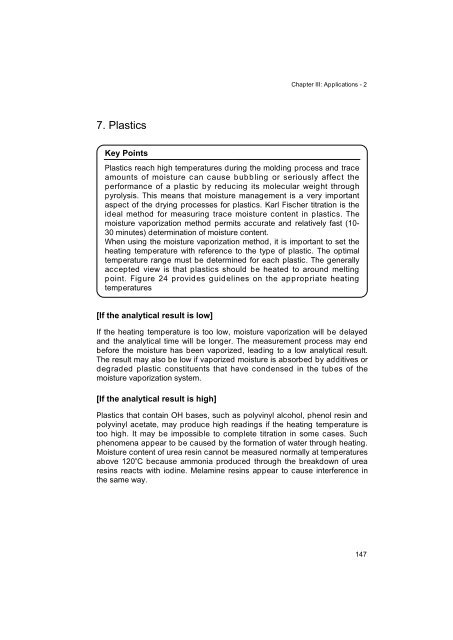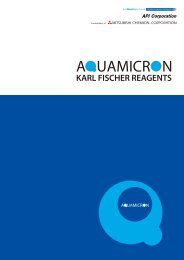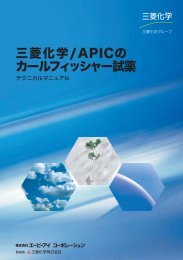Development of Karl Fischer Reagents
Development of Karl Fischer Reagents
Development of Karl Fischer Reagents
You also want an ePaper? Increase the reach of your titles
YUMPU automatically turns print PDFs into web optimized ePapers that Google loves.
7. Plastics<br />
Key Points<br />
Chapter III: Applications - 2<br />
Plastics reach high temperatures during the molding process and trace<br />
amounts <strong>of</strong> moisture can cause bubbling or seriously affect the<br />
performance <strong>of</strong> a plastic by reducing its molecular weight through<br />
pyrolysis. This means that moisture management is a very important<br />
aspect <strong>of</strong> the drying processes for plastics. <strong>Karl</strong> <strong>Fischer</strong> titration is the<br />
ideal method for measuring trace moisture content in plastics. The<br />
moisture vaporization method permits accurate and relatively fast (10-<br />
30 minutes) determination <strong>of</strong> moisture content.<br />
When using the moisture vaporization method, it is important to set the<br />
heating temperature with reference to the type <strong>of</strong> plastic. The optimal<br />
temperature range must be determined for each plastic. The generally<br />
accepted view is that plastics should be heated to around melting<br />
point. Figure 24 provides guidelines on the appropriate heating<br />
temperatures<br />
[If the analytical result is low]<br />
If the heating temperature is too low, moisture vaporization will be delayed<br />
and the analytical time will be longer. The measurement process may end<br />
before the moisture has been vaporized, leading to a low analytical result.<br />
The result may also be low if vaporized moisture is absorbed by additives or<br />
degraded plastic constituents that have condensed in the tubes <strong>of</strong> the<br />
moisture vaporization system.<br />
[If the analytical result is high]<br />
Plastics that contain OH bases, such as polyvinyl alcohol, phenol resin and<br />
polyvinyl acetate, may produce high readings if the heating temperature is<br />
too high. It may be impossible to complete titration in some cases. Such<br />
phenomena appear to be caused by the formation <strong>of</strong> water through heating.<br />
Moisture content <strong>of</strong> urea resin cannot be measured normally at temperatures<br />
above 120 � C because ammonia produced through the breakdown <strong>of</strong> urea<br />
resins reacts with iodine. Melamine resins appear to cause interference in<br />
the same way.<br />
147




